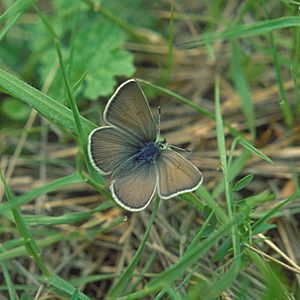Fender's blue butterfly facts for kids
Quick facts for kids Icaricia icarioides fenderi |
|
|---|---|
 |
|
| Conservation status | |
| Scientific classification |
|
| Kingdom: | Animalia |
| Phylum: | Arthropoda |
| Class: | Insecta |
| Order: | Lepidoptera |
| Family: | Lycaenidae |
| Genus: | Icaricia |
| Species: | |
| Subspecies: |
I. i. fenderi
|
| Trinomial name | |
| Icaricia icarioides fenderi (Macy, 1931)
|
|
| Synonyms | |
|
|
Fender's blue butterfly (Icaricia icarioides fenderi) is an endangered subspecies of butterfly endemic to the Willamette Valley of northwestern Oregon, United States. The subspecies was first documented in the 1920s and was described to science in 1931 by biologist Ralph Macy. He named it for his friend, Kenneth Fender, an entomologist and mail carrier. The subspecies was not seen after the 1930s and was presumed extinct. Small populations were rediscovered in 1989. Its eponym, Fender, had died nine years earlier. In January 2000, Fender's blue butterfly was added to the Endangered Species List by the U.S. Fish and Wildlife Service. The largest known populations now exist in the Baskett Slough National Wildlife Refuge. A 2014 study reintroduced this subspecies to William L. Finley National Wildlife Refuge. The potential range of the butterfly extends from south and west of Portland, OR to south of Eugene, OR.
Fender's blue butterfly is host-specific on Kincaid's lupine, a rare subspecies of the common sulphur lupine. The adult deposits its eggs on the plant in spring. After emerging and feeding, the larva winters in the root system. In spring it continues to feed before undergoing metamorphosis. As an adult it lives for no more than three weeks, during which time it mates and the female seeks Kincaid's lupines on which to oviposit. The lupine's habitat has been reduced by agriculture and urbanization, and only isolated areas have enough land for populations to persist.
Images for kids



